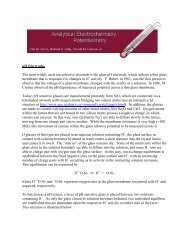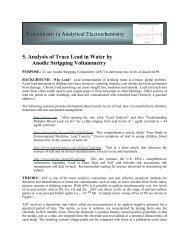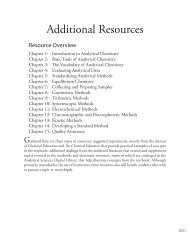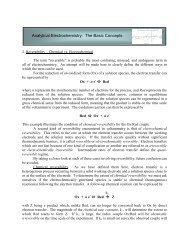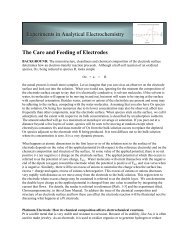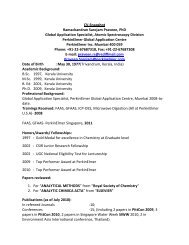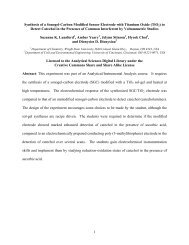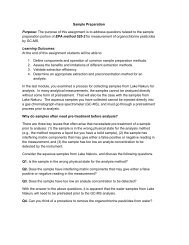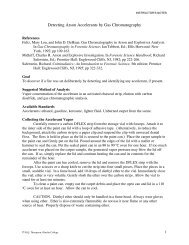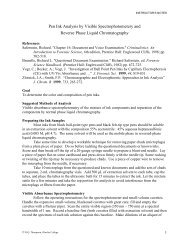Chapter 5 - Analytical Sciences Digital Library
Chapter 5 - Analytical Sciences Digital Library
Chapter 5 - Analytical Sciences Digital Library
Create successful ePaper yourself
Turn your PDF publications into a flip-book with our unique Google optimized e-Paper software.
176 <strong>Analytical</strong> Chemistry 2.0<br />
where y i is the i th experimental value, and ŷ i<br />
is the corresponding value predicted<br />
by the regression line in equation 5.15. Note that the denominator<br />
of equation 5.19 indicates that our regression analysis has n–2 degrees of<br />
freedom—we lose two degree of freedom because we use two parameters,<br />
the slope and the y-intercept, to calculate ŷ i<br />
.<br />
A more useful representation of the uncertainty in our regression is<br />
to consider the effect of indeterminate errors on the slope, b 1 , and the y-<br />
intercept, b 0 , which we express as standard deviations.<br />
s<br />
b1<br />
=<br />
∑<br />
ns<br />
2<br />
n x − x<br />
i<br />
i<br />
2<br />
r<br />
∑<br />
i<br />
i<br />
2<br />
=<br />
2<br />
sr<br />
2<br />
∑( x − x<br />
i ) 5.20<br />
i<br />
s<br />
b0<br />
=<br />
∑<br />
s<br />
x<br />
2 2<br />
r i<br />
i<br />
2<br />
n x − x<br />
i<br />
i<br />
∑<br />
∑<br />
i<br />
i<br />
2<br />
=<br />
s<br />
r∑<br />
x<br />
2 2<br />
i<br />
i<br />
∑( −<br />
i )<br />
n x x<br />
i<br />
2 5.21<br />
We use these standard deviations to establish confidence intervals for the<br />
expected slope, b 1 , and the expected y-intercept, b 0<br />
β 1<br />
= b 1<br />
± ts b 5.22<br />
1<br />
β 0<br />
= b 0<br />
± ts b 5.23<br />
0<br />
You might contrast this with equation<br />
4.12 for the confidence interval around a<br />
sample’s mean value.<br />
As you work through this example, remember<br />
that x corresponds to C std , and<br />
that y corresponds to S std .<br />
where we select t for a significance level of a and for n–2 degrees of freedom.<br />
Note that equation 5.22 and equation 5.23 do not contain a factor of<br />
( n)<br />
−1 because the confidence interval is based on a single regression line.<br />
Again, many calculators, spreadsheets, and computer software packages<br />
provide the standard deviations and confidence intervals for the slope and<br />
y-intercept. Example 5.10 illustrates the calculations.<br />
Example 5.10<br />
Calculate the 95% confidence intervals for the slope and y-intercept from<br />
Example 5.9.<br />
So l u t i o n<br />
We begin by calculating the standard deviation about the regression. To do<br />
this we must calculate the predicted signals, ŷ i<br />
, using the slope and y‐intercept<br />
from Example 5.9, and the squares of the residual error, ( y − yˆ )<br />
2 .<br />
i i<br />
Using the last standard as an example, we find that the predicted signal is<br />
yˆ = b + bx = 0. 209 + 120. 706×<br />
0. 500 60.<br />
562<br />
6 0 1 6 ( )=<br />
and that the square of the residual error is



